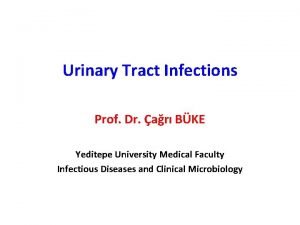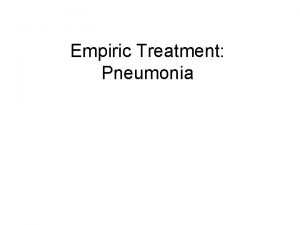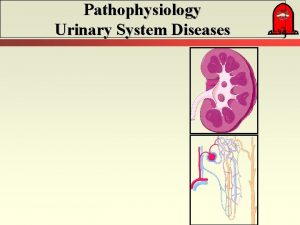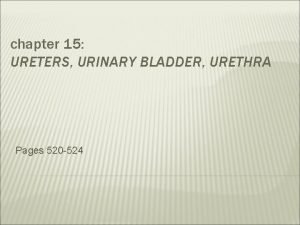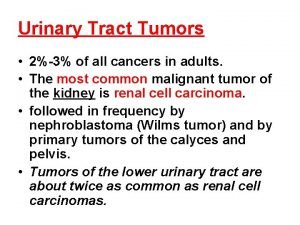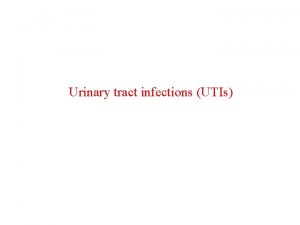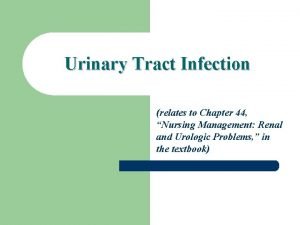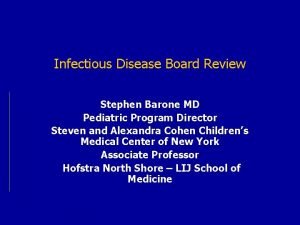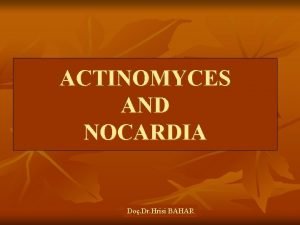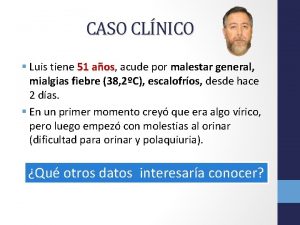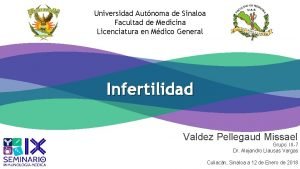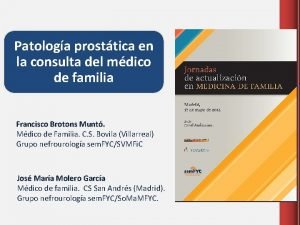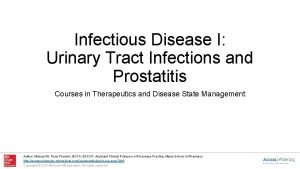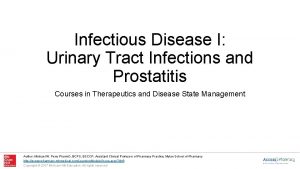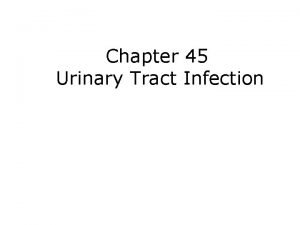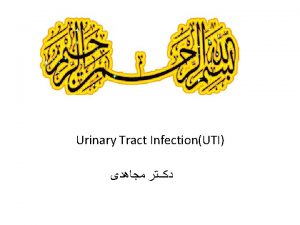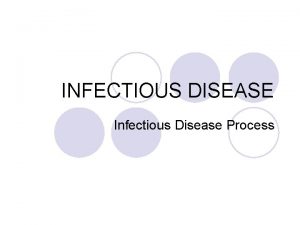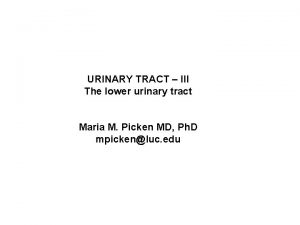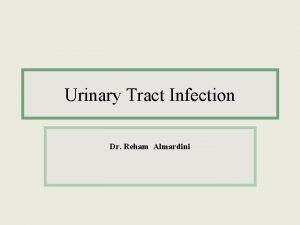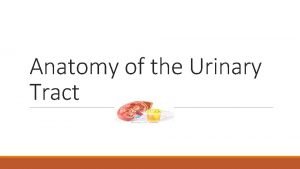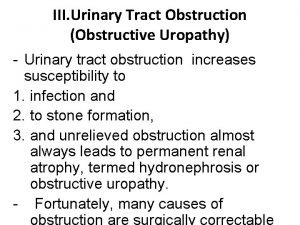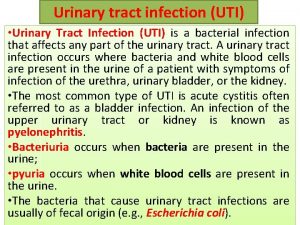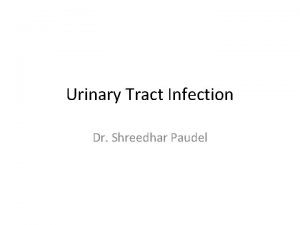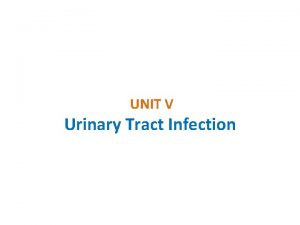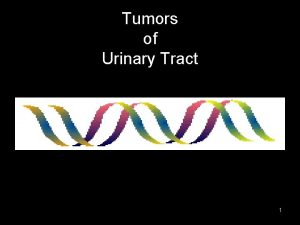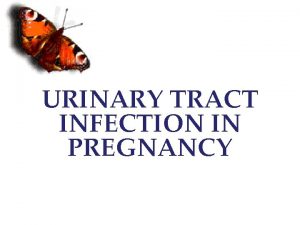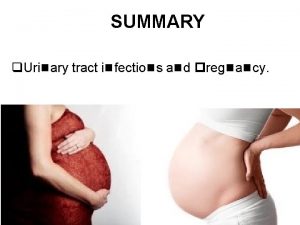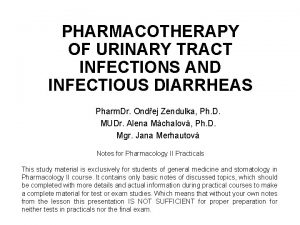Infectious Disease I Urinary Tract Infections and Prostatitis























- Slides: 23

Infectious Disease I: Urinary Tract Infections and Prostatitis Courses in Therapeutics and Disease State Management Author: Michael W. Perry Pharm. D, BCPS, BCCCP; Assistant Clinical Professor of Pharmacy Practice; Mylan School of Pharmacy http: //accesspharmacy. mhmedical. com/qa. aspx#tab 6 Copyright © 2017 Mc. Graw-Hill Education. All rights reserved

Learning Objectives • Define the differences between uncomplicated and complicated urinary tract infections (UTIs) • Identify the most common organisms that cause UTIs • Describe the various routes in which bacteria enter the urinary tract and cause infection • Discuss how host defense mechanisms and bacterial virulence factors play a role in the development of UTIs • Describe the clinical presentation of lower and upper UTIs • Evaluate the various laboratory tests utilized in the diagnosis of UTIs Author: Michael W. Perry Pharm. D, BCPS, BCCCP; Assistant Clinical Professor of Pharmacy Practice; Mylan School of Pharmacy http: //accesspharmacy. mhmedical. com/qa. aspx#tab 6 Copyright © 2017 Mc. Graw-Hill Education. All rights reserved

Learning Objectives • Select an appropriate antimicrobial regimen for the treatment of uncomplicated and complicated UTIs • Analyze antimicrobial regimens for appropriateness given varied antibiotic resistance • Develop a monitoring plan for a treatment regimen utilizing the goals of therapy in the treatment of UTIs • Select an appropriate antimicrobial regimen for patients with acute pyelonephritis • Describe how UTIs in males differ from UTIs in females Author: Michael W. Perry Pharm. D, BCPS, BCCCP; Assistant Clinical Professor of Pharmacy Practice; Mylan School of Pharmacy http: //accesspharmacy. mhmedical. com/qa. aspx#tab 6 Copyright © 2017 Mc. Graw-Hill Education. All rights reserved

Learning Objectives • Select appropriate treatment or prophylaxis in patients with recurrent UTIs • Design appropriate antimicrobial treatment of UTIs in special patient populations such as pregnant females • Classify bacterial prostatitis as acute or chronic and choose appropriate antimicrobial treatment and/or prophylaxis • Evaluate the patient-centered considerations in the treatment of UTIs in the selection of antimicrobial therapy Author: Michael W. Perry Pharm. D, BCPS, BCCCP; Assistant Clinical Professor of Pharmacy Practice; Mylan School of Pharmacy http: //accesspharmacy. mhmedical. com/qa. aspx#tab 6 Copyright © 2017 Mc. Graw-Hill Education. All rights reserved

Required and Recommended Reading Required Reading Coyle EA, Prince RA. Chapter 94. Urinary Tract Infections and Prostatitis. In: Di. Piro JT, Talbert RL, Yee GC, Matzke GR, Wells BG, Posey L. eds. Pharmacotherapy: A Pathophysiologic Approach, 9 e. New York, NY: Mc. Graw-Hill; 2014. Recommended Reading • Gupta K, Hooton TM, Naber KG, et al. International clinical practice guidelines for the treatment of acute uncomplicated cystitis and pyelonephritis in women: A 2010 update by the Infectious Diseases Society of America and the European Society for Microbiology and Infectious Diseases. Clin Infect Dis 2011; 52(5): e 103–e 120. • Hooten TM, Bradley SF, Cardenas DD, et al. Diagnosis, prevention, and treatment of catheter-associated urinary tract infections in adults: 2009 International Clinical Practice Guidelines from the Infectious Diseases Society of America. Clin Infect Dis 2010; 50: 625– 663. • Nicolle LE, Bradley S, Colgan R, et al. Infectious disease society of America guidelines for diagnosis and treatment of asymptomatic bacteriuria in adults. Clin Infect Dis 2005; 40: 643 – 654. Author: Michael W. Perry Pharm. D, BCPS, BCCCP; Assistant Clinical Professor of Pharmacy Practice; Mylan School of Pharmacy http: //accesspharmacy. mhmedical. com/qa. aspx#tab 6 Copyright © 2017 Mc. Graw-Hill Education. All rights reserved

Overview: Urinary Tract Infections and Prostatitis • Urinary tract infections is a diverse group of infections that are caused by microorganisms in the urinary tract that cannot be accounted for by contamination • Urethritis • Cystitis • Pyelonephritis • Bacterial prostatitis is an acute or chronic infection that results in the inflammation of the prostate gland surrounding tissue Author: Michael W. Perry Pharm. D, BCPS, BCCCP; Assistant Clinical Professor of Pharmacy Practice; Mylan School of Pharmacy http: //accesspharmacy. mhmedical. com/qa. aspx#tab 6 Copyright © 2017 Mc. Graw-Hill Education. All rights reserved

Pathophysiology Urinary Tract Infections • Route of Infection • Ascending from colonization of the urethra • Hematogenous spread from distant primary infections via the blood • Host Defense Mechanisms • • p. H Osmolality Urea concentrations Organic acid concentration Prostatic secretions (male patients) Complete Voiding glycosaminoglycan layer of bladder Estrogen levels and normal vaginal flora (female patients) • Bacterial Virulence Factors • Ability to adhere to epithelium of the urinary tract • Hemolysin and aerobactin Author: Michael W. Perry Pharm. D, BCPS, BCCCP; Assistant Clinical Professor of Pharmacy Practice; Mylan School of Pharmacy http: //accesspharmacy. mhmedical. com/qa. aspx#tab 6 Copyright © 2017 Mc. Graw-Hill Education. All rights reserved

Most Common Pathogens Urinary Tract Infections Uncomplicated • • • Escherichia coli Staphylococcus saprophyticus Klebsiella pneumonia Proteus sp. Pseudomonas aeruginosa Enterococcus sp. Complicated • • Escherichia coli Proteus sp. Klebsiella pneumonia Enterobacter sp. Pseudomonas aeruginosa Staphylococcus sp. Enterococcus sp. Author: Michael W. Perry Pharm. D, BCPS, BCCCP; Assistant Clinical Professor of Pharmacy Practice; Mylan School of Pharmacy http: //accesspharmacy. mhmedical. com/qa. aspx#tab 6 Copyright © 2017 Mc. Graw-Hill Education. All rights reserved

Clinical Presentation Urinary Tract Infections Signs and Symptoms • Gross Hematuria • Lower UTI • • • Dysuria Urgency Frequency Nocturia Suprapubic heaviness • Upper UTI • • Flank pain Fever Nausea & vomiting Malaise Diagnosis • Urinalysis • • Bacteriuria Pyuria ( WBC count > 10 x 106/L) Presence of nitrites Presence of Leukocyte esterase • Antibody coated UTI (upper UTI) • Urine Gram stain and Culture Author: Michael W. Perry Pharm. D, BCPS, BCCCP; Assistant Clinical Professor of Pharmacy Practice; Mylan School of Pharmacy http: //accesspharmacy. mhmedical. com/qa. aspx#tab 6 Copyright © 2017 Mc. Graw-Hill Education. All rights reserved

Clinical Presentation Urinary Tract Infections • Diagnosis is made primarily with laboratory tests on appropriate urine samples to demonstrate a significant number of microorganisms to distinguish between infection and contamination • Urine Collection via midstream clean-catch method • Bacterial Count • Pyuria, Hematuria, Proteinuria • Chemistry • Nitrites • Leukocyte Esterase • Culture Author: Michael W. Perry Pharm. D, BCPS, BCCCP; Assistant Clinical Professor of Pharmacy Practice; Mylan School of Pharmacy http: //accesspharmacy. mhmedical. com/qa. aspx#tab 6 Copyright © 2017 Mc. Graw-Hill Education. All rights reserved

Treatment Overview • The majority of patients with an uncomplicated UTI can be cured with a short course of antibiotics • Goals of treatment • • Eradicate the invading microorganism Prevent and treat systemic signs and symptoms of infection Prevent reoccurrence of infection Prevent antibiotic induced adverse effects • Antibiotic empiric therapy can be modified and narrowed with urine culture and sensitivity data Author: Michael W. Perry Pharm. D, BCPS, BCCCP; Assistant Clinical Professor of Pharmacy Practice; Mylan School of Pharmacy http: //accesspharmacy. mhmedical. com/qa. aspx#tab 6 Copyright © 2017 Mc. Graw-Hill Education. All rights reserved

Nonpharmacological and Supportive Prevention and Treatment Urinary Tract Infections • Hydration • Cranberry juice is commonly recommended, but has conflicting data concerning its use in the prevention and treatment of UTIs • Lactobacillus probiotics also may aid in the prevention of female UTIs by decreasing the vaginal p. H, thereby decreasing E. coli colonization • Urinary analgesics • Phenazopyridine HCl • Topical estrogen replacement for postmenopausal women may help in the prevention of recurrent UTIs Author: Michael W. Perry Pharm. D, BCPS, BCCCP; Assistant Clinical Professor of Pharmacy Practice; Mylan School of Pharmacy http: //accesspharmacy. mhmedical. com/qa. aspx#tab 6 Copyright © 2017 Mc. Graw-Hill Education. All rights reserved

Pharmacological Treatment Urinary Tract Infections • Type of Infection • Acute uncomplicated cystitis • Symptomatic abacteriuria • Asymptomatic bacteriuria • Complicated UTIs • Recurrent infections • Prostatitis • Local resistance rates of E. coli to commonly prescribed antibiotics must be taken into consideration Author: Michael W. Perry Pharm. D, BCPS, BCCCP; Assistant Clinical Professor of Pharmacy Practice; Mylan School of Pharmacy http: //accesspharmacy. mhmedical. com/qa. aspx#tab 6 Copyright © 2017 Mc. Graw-Hill Education. All rights reserved

Pharmacological Treatment Acute Uncomplicated Cystitis Link: Algorithm for Management of UTIs in Females Author: Michael W. Perry Pharm. D, BCPS, BCCCP; Assistant Clinical Professor of Pharmacy Practice; Mylan School of Pharmacy http: //accesspharmacy. mhmedical. com/qa. aspx#tab 6 Copyright © 2017 Mc. Graw-Hill Education. All rights reserved

Pharmacological Treatment Complicated UTIs in Male Patients Link: Management of UTIs in Males Author: Michael W. Perry Pharm. D, BCPS, BCCCP; Assistant Clinical Professor of Pharmacy Practice; Mylan School of Pharmacy http: //accesspharmacy. mhmedical. com/qa. aspx#tab 6 Copyright © 2017 Mc. Graw-Hill Education. All rights reserved

Pharmacological Treatment Link: Table on Commonly Used Antimicrobial Agents in the Treatment of Urinary Tract Infections Author: Michael W. Perry Pharm. D, BCPS, BCCCP; Assistant Clinical Professor of Pharmacy Practice; Mylan School of Pharmacy http: //accesspharmacy. mhmedical. com/qa. aspx#tab 6 Copyright © 2017 Mc. Graw-Hill Education. All rights reserved

Pathophysiology Bacterial prostatitis • An inflammation of the prostate gland surrounding tissue due to an infection • Acute • Chronic • Physiologic factors may contribute to the development of prostatitis • Altered prostate secretory functions • Decreased zinc • Decreased prostatic antibacterial factor • Altered prostatic p. H • Manipulation of prostate • Catheters • Urethral instrumentation • Transurethral prostatectomy Author: Michael W. Perry Pharm. D, BCPS, BCCCP; Assistant Clinical Professor of Pharmacy Practice; Mylan School of Pharmacy http: //accesspharmacy. mhmedical. com/qa. aspx#tab 6 Copyright © 2017 Mc. Graw-Hill Education. All rights reserved

Most Common Pathogens • E. coli is the predominant organism • Other gram-negative organisms • • • K. pneumonia P. mirabilis P. aeruginosa Enterobacter sp. Serratia sp. Author: Michael W. Perry Pharm. D, BCPS, BCCCP; Assistant Clinical Professor of Pharmacy Practice; Mylan School of Pharmacy http: //accesspharmacy. mhmedical. com/qa. aspx#tab 6 Copyright © 2017 Mc. Graw-Hill Education. All rights reserved

Clinical Presentation • Acute Bacterial Prostatitis Constitutional Symptoms • • High fever Chills Malaise Myalgia • Specific Chronic Bacterial Prostatitis • Voiding difficulties • Low back pain • Perineal and suprapubic discomfort • Localized pain • Voiding difficulties • Nocturia • Physical Exam reveals a swollen, tender, tense, or indurated gland Author: Michael W. Perry Pharm. D, BCPS, BCCCP; Assistant Clinical Professor of Pharmacy Practice; Mylan School of Pharmacy http: //accesspharmacy. mhmedical. com/qa. aspx#tab 6 Copyright © 2017 Mc. Graw-Hill Education. All rights reserved

Treatment Overview • Treatment similar to the UTI treatment • Empiric antimicrobial therapy should penetrate into the prostate and cover E. coli • Duration of antibiotics is normally 4 weeks Author: Michael W. Perry Pharm. D, BCPS, BCCCP; Assistant Clinical Professor of Pharmacy Practice; Mylan School of Pharmacy http: //accesspharmacy. mhmedical. com/qa. aspx#tab 6 Copyright © 2017 Mc. Graw-Hill Education. All rights reserved

Pharmacological Treatment Link: Table on Overview of Outpatient Antimicrobial Therapy for Lower Tract Infections in Adults Author: Michael W. Perry Pharm. D, BCPS, BCCCP; Assistant Clinical Professor of Pharmacy Practice; Mylan School of Pharmacy http: //accesspharmacy. mhmedical. com/qa. aspx#tab 6 Copyright © 2017 Mc. Graw-Hill Education. All rights reserved

Summary • UTIs are common and require prompt treatment with antibiotics after diagnosis • E. coli is the most common pathogen isolated in all types of UTIs • Antibiotic therapy choice and duration depends on the type of UTI • Uncomplicated UTIs require short courses (3 to 5 days) • Complicated UTIs require longer courses (10 to 14 days) Author: • Michael W. Perry Pharm. D, BCPS, BCCCP; Assistant Clinical Professor of Pharmacy of Practice; Mylan School of Pharmacy Prostatitis requires up to 4 weeks therapy http: //accesspharmacy. mhmedical. com/qa. aspx#tab 6 Copyright © 2017 Mc. Graw-Hill Education. All rights reserved

References • Coyle EA, Prince RA. Chapter 94. Urinary Tract Infections and Prostatitis. In: Di. Piro JT, Talbert RL, Yee GC, Matzke GR, Wells BG, Posey L. eds. Pharmacotherapy: A Pathophysiologic Approach, 9 e. New York, NY: Mc. Graw-Hill; 2014. • Gupta K, Hooton TM, Naber KG, et al. International clinical practice guidelines for the treatment of acute uncomplicated cystitis and pyelonephritis in women: A 2010 update by the Infectious Diseases Society of America and the European Society for Microbiology and Infectious Diseases. Clin Infect Dis 2011; 52(5): e 103 –e 120. • Hooten TM, Bradley SF, Cardenas DD, et al. Diagnosis, prevention, and treatment of catheter-associated urinary tract infections in adults: 2009 International Clinical Practice Guidelines from the Infectious Diseases Society of America. Clin Infect Dis 2010; 50: 625– 663. • Nicolle LE, Bradley S, Colgan R, et al. Infectious disease society of America guidelines for diagnosis and treatment of asymptomatic bacteriuria in adults. Clin Infect Dis 2005; 40: 643– 654. Author: Michael W. Perry Pharm. D, BCPS, BCCCP; Assistant Clinical Professor of Pharmacy Practice; Mylan School of Pharmacy http: //accesspharmacy. mhmedical. com/qa. aspx#tab 6 Copyright © 2017 Mc. Graw-Hill Education. All rights reserved
 Chapter 26 infectious disease prevention and control
Chapter 26 infectious disease prevention and control Complicated uti symptoms
Complicated uti symptoms Complicated urinary tract infection
Complicated urinary tract infection Histological structure of kidney
Histological structure of kidney Urethra
Urethra Tumor in the urinary tract
Tumor in the urinary tract Urinary tract infection in pregnancy ppt
Urinary tract infection in pregnancy ppt Urised otc
Urised otc Bladder infection
Bladder infection Infectious disease quality controls
Infectious disease quality controls Stages of infection
Stages of infection Stages of infectious disease
Stages of infectious disease Stridor
Stridor Infectious disease
Infectious disease Hennepin county infectious disease manual
Hennepin county infectious disease manual Smallest infectious agent
Smallest infectious agent Pyramidal vs extrapyramidal tract
Pyramidal vs extrapyramidal tract Olivospinal tract vs tectospinal tract
Olivospinal tract vs tectospinal tract Cefixoma
Cefixoma Clasificacion prostatitis
Clasificacion prostatitis Prostate mri pi rads
Prostate mri pi rads Fisiopatologia de prostatitis
Fisiopatologia de prostatitis Prostatitis abacteriana y psa
Prostatitis abacteriana y psa Bharathi viswanathan
Bharathi viswanathan

